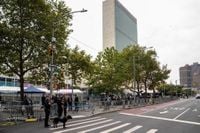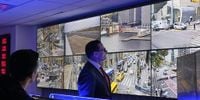Federal agents have disrupted what officials describe as a vast, technologically sophisticated network in the New York area that posed a direct threat to senior U.S. government officials and the city’s critical infrastructure. The operation, which unfolded just days ahead of the United Nations General Assembly in September 2025, has drawn comparisons to a high-stakes spy thriller, with investigators racing against the clock to prevent a potentially catastrophic attack.
According to the U.S. Secret Service, the investigation began earlier in the spring of 2025, when a series of anonymous telephone threats targeted high-level government officials. The nature and precision of these threats immediately raised alarms within the intelligence community, prompting a swift and coordinated response. As reported by Dow Jones & Company, law enforcement officials soon uncovered a cache of advanced technological equipment hidden in empty apartments scattered across the metropolitan area. These devices, officials say, bore unmistakable signs of foreign involvement and were capable of wreaking havoc on New York’s cellular network.
“The Secret Service acted quickly to prevent an attack that could have severely disrupted New York during the UN General Assembly meeting,” the agency stated. The timing could hardly have been more critical: with world leaders converging on the city for the high-profile diplomatic gathering, the risk of disruption carried global implications. Had the attack succeeded, authorities believe it could have paralyzed communications, impeded emergency services, and endangered both local residents and international dignitaries.
The scale of the plot stunned even seasoned investigators. Agents discovered more than 300 SIM card servers and an astonishing 100,000 SIM cards at several locations within a 35-mile radius of New York City. These SIM card servers, essentially small computers capable of routing vast volumes of cellular traffic, can be used for both legitimate and malicious purposes. In this case, officials believe the network was designed to facilitate mass anonymous communications and enable the perpetrators to carry out coordinated threats or cyberattacks without easy detection.
“This investigation culminated in thwarting a telecom threat in the New York City area ahead of the United Nations General Assembly in late September 2025,” reported Dow Jones & Company. The Secret Service’s rapid response was not just a matter of local security—it was a move to safeguard the integrity of international diplomacy on American soil. The agency’s statement underscored the urgency: “Any attack could have severely disrupted New York at a time when world leaders are gathering in the city.”
The operation’s success was the result of months of painstaking detective work. Investigators followed the digital trail left by the anonymous threats, tracing them back to a series of properties that, on the surface, appeared unremarkable. But inside, agents found rooms filled with racks of blinking servers, boxes of unused SIM cards, and the telltale evidence of a coordinated, well-funded operation. Law enforcement sources say the sophistication of the setup pointed strongly to foreign actors—though, as of this writing, officials have not publicly named any specific country or group believed to be behind the scheme.
While the Secret Service has not disclosed the exact methods used to dismantle the network, cybersecurity experts note that such operations require both technical prowess and speed. SIM card servers, once activated, can be quickly relocated or shut down remotely, making it crucial for authorities to act on intelligence without delay. The fact that agents were able to seize more than 300 servers and a massive inventory of SIM cards suggests that they caught the perpetrators off-guard, likely preventing the planned attack from ever being launched.
The broader implications of the case have not gone unnoticed. New York City, already a prime target for both physical and cyber threats, faces unique vulnerabilities due to its dense population and role as a global communications hub. The discovery that empty apartments were being used as staging grounds for a potential telecom attack highlights the evolving tactics of those seeking to undermine U.S. security. “Investigators discovered a cache of tech equipment in empty apartments tied to foreign actors capable of crippling New York’s cellular network,” according to Dow Jones & Company. This chilling detail has sparked renewed calls for vigilance among landlords, property managers, and city officials.
Federal authorities have not commented on whether any arrests were made during the operation or if suspects remain at large. However, the dismantling of the network is being hailed as a significant victory for U.S. law enforcement and intelligence agencies. “As of September 24, 2025, the US Secret Service has thwarted an imminent telecommunications attack in New York City,” reported LNL, emphasizing the gravity of what was at stake.
The timing of the plot, coinciding with the UN General Assembly, has raised questions about whether the attack was intended to embarrass the U.S. on the world stage or disrupt international negotiations. While officials have not confirmed a specific motive, the convergence of global leaders in New York each September is widely seen as a period of heightened risk. The city’s security apparatus, already on high alert for physical threats, now faces the added challenge of defending against increasingly sophisticated cyber and telecommunications attacks.
In the wake of the operation, city and federal officials are reviewing protocols for monitoring and securing telecommunications infrastructure. Experts warn that the proliferation of SIM card servers and other easily concealed technology presents an ongoing challenge. “This investigation culminated in thwarting a telecom threat in the New York City area,” the Secret Service emphasized, but they also cautioned that vigilance must be maintained to prevent future incidents.
For many New Yorkers, the news serves as a sobering reminder of the city’s vulnerability—and its resilience. The successful disruption of the plot is being credited not just to the Secret Service, but to the coordinated efforts of multiple federal, state, and local agencies. Their ability to act decisively, officials say, may have averted a crisis with far-reaching consequences.
As the city returns to its usual frenetic pace following the high-stakes drama, questions linger about the origins and ultimate goals of the thwarted network. What is clear, however, is that the threat was real, the response was swift, and the city’s defenders remain ever watchful.


